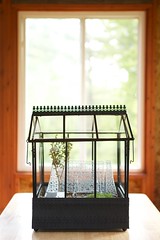Literrariums: The Art & Science of Story Terrariums
The Art & Science of Story Terrariums

Creating a literrarium can engage the spirit of creative free play by interpreting the scene from a favorite work of literature or picture book in miniature while exploring the field of science and biology in its planning and care.
The intersections of science and literature are perhaps endless – stories can help to teach kids about everything from weather to atomic structure in an interesting, creative, and thought-provoking way. However, it is not often that a combination of literature and science results in hands-on gardening experience that serves as a beautiful and unique home decoration and reminder of a favorite story.
Literrariums – a combination of the words “literature” and “terrarium” – do exactly this! Also called story terrariums, literrariums depict scenes or represent themes from stories in miniature. A literrarium might be a three-dimensional representation of a favorite children’s book illustration, a woodland scene including important items or characters from a book, or a landscape showing a story’s setting. Whatever they represent, literrariums include lush greenery, as well as natural objects and other small-scale details that complete the scene – meaning that a literrarium project offers lots of space for creatively conveying the main ideas of a story while simultaneously learning how to effectively engineer the plants, mosses, and soil that may live inside.
Such a project has many uses. Families could create their own literrariums together, inspired by their favorite bedtime stories; educators could use a literrarium project as a way to challenge students to convey ideas creatively; caring crafters of all ages can create personalized literrariums for the book-lovers in their lives as gifts. It’s easy enough to decide your theme – just choose a book that you (or a friend or family member) love, select your favorite scene or illustration, and you’re off!
Before embarking on a literrarium project, be sure to read up on proper terrarium creation and maintenance. While terrarium plants are available at most gardening shops, there are many different kinds and they don’t always enjoy living together! Be sure to learn about what makes a terrarium different from most indoor plants – it’s important to keep in mind that unlike the orchid, jade, or a spider plant that might inhabit your kitchen, a terrarium exists within a closed environment. Aside from thinking about temperature and sunlight in your home, it’s important to consider the amount of moisture that the plants that you include will need – if you combine plants that love to be damp with some that don’t, your literrarium is bound to either dry up or mold!
This portion of the project allows for some great science learning to take place. Students will get firsthand experience with the importance of thinking about habitat and the needs of various species, and they’ll grow to understand the environment that they’ve created very well if they care for their literrarium properly! For assistance with the moss and plants portion of the project, check out these titles:
- Tiny World Terrariums: A Step-by-Step Guide
-
Kids’ Container Gardening: Year-Round Projects for Inside and Out
- Gardening in Miniature: Create Your Own Tiny Living World
[Photo credit: (cc) Susy Morris]
 Hilltown Families
Hilltown Families 




























